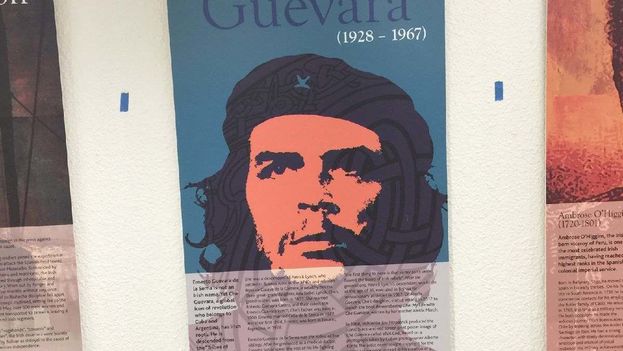
![]() 14ymedio, Mario Penton, Miami, 1 September 2017 — Miami Dade County Mayor Carlos A. Giménez, whose family had to go into exile after the Cuban Revolution in 1959, never thought that his image would be linked to that of Ernesto Che Guevara, one of the “bearded ones” who established communism in his homeland.
14ymedio, Mario Penton, Miami, 1 September 2017 — Miami Dade County Mayor Carlos A. Giménez, whose family had to go into exile after the Cuban Revolution in 1959, never thought that his image would be linked to that of Ernesto Che Guevara, one of the “bearded ones” who established communism in his homeland.
The image of Guevara welcomed passengers at Miami International Airport for a few hours on Thursday night and continuing into Friday morning, just a few yards from another image showing Giménez as part of the exhibition The Irish in Latin America, sponsored by the Irish embassy in the United States to highlight the contributions of immigrants from that country to the history and culture of Latin American.
“Che Guevara wanted to make people ‘an effective, violent, selective and cold killing machine’, as he put it. Far from being considered a hero, they should measure him by the same yardstick as Osama Bin Laden”
“The picture of Che is no longer there, they took it away,” said an airport employee who asked to remain anonymous.
“I saw it last night and I did not agree. They should have put another photo of a celebrated person from Cuba, but not Che who was a murderer. It’s fine that the communists in Cuban or Venezuela display it there, but not here,” said the employee of Cuban origin.
Greg Chin, communications director for the airport told 14ymedio that in one of the preliminary versions of the art exhibition organizers presented the poster with the image of Argentine guerrilla, but that the authorities of the terminal made it clear they would not display it out of respect for the community.
“It was taken down early in the morning. It wasn’t on display at the airport for even 12 hours,” he explained.
The image of Giménez remains at the beginning of the exhibition ,which contains a total of 27 posters with personalities of Irish descent that marked Latin American history. The legend under his image extols his Irish ancestry and credits the ties he has created between the two communities.
The mayor’s office said he “deeply regrets” the incident and they were unaware of the images that would be displayed at the airport.
“In an essay about the exhibition they included the image of Che Guevara and the staff of the air terminal themselves expressed their rejection of this figure and what it represents in Miami,” said Stephanie Severino, a spokeswoman for the mayor’s office.
The exhibition is divided by the main countries where the Irish emigrated to. Five of the images are dedicated to Cubans and highlight historical figures such as José Martí, Father Felix Varela, Ricardo O’Farrill and Alejandro O’Reilly.
Ernesto Guevara, born in Argentina, participated in the struggle against Batista and then joined the revolutionary government with Fidel Castro; the Irish exhibition presented him as a physician committed to social justice.

“After graduating as a doctor, Ernesto spent the rest of his life fighting against poverty and injustice in Latin America,” declared the exhibit, classifying him as “one of the most celebrated revolutionaries of the twentieth century.”
The image of Che that was displayed last night at the airport’s E terminal was created in 1968 by Irish artist Jim Fitzpatrick. It is a poster in white and red with the image of Che Guevara under the name VIVA CHE, and is inspired by the famous photograph taken by Alberto Korda.
The Irish ancestry of Guevara comes to him through his paternal grandmother, Ana Isabel Lynch, born in Argentina. The family’s Irish roots from Patrick Lynch, who established himself in Buenos Aires in 1740, married to a wealthy heiress.
The Irish embassy in the United States told this newspaper that the panel with the image of Che was not supposed to be included . “It was removed as soon as we discovered the error this morning. We fully understand the sensitivity and deeply regret the error,” said communications director Carol Jordan.
María Werlau, director of the NGO Cuba Archive, dedicated to collecting information on Cuban historical memory, believes that the image of Che Guevara is one of the “most successful” advertising campaigns in history.
Werlau is the author of a book entitled The Forgotten Victims of ‘Che’ Guevara which details the shootings directed by the Argentine guerrilla after summary trials in Havana’s La Cabaña fortress.
“Che’s biographies are voluminous but almost never thoroughly investigate his crimes. Guevara was one of the forerunners of the infamous UMAP in Cuba [forced labor camps for dissidents, priests and homosexuals]. He wrote against the Indians and against the blacks. In his own writings he recognized that he liked to kill,” she explained.
For Werlau, placing the image of Che next to patriots like Martí and Varela is the “product of the ignorance.” According to the expert, the Cuban exile has not been able to raise awareness of the need to dismantle the propaganda of the Government of Havana.
“Che Guevara wanted to make people ‘an effective, violent, selective and cold killing machine’, as he put it. Far from being considered a hero, they should measure him by the same yardstick as Osama Bin Laden,” she added.
